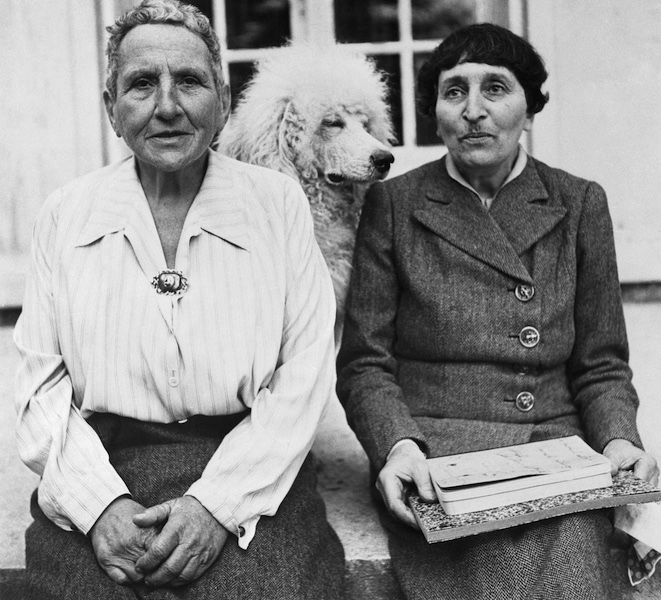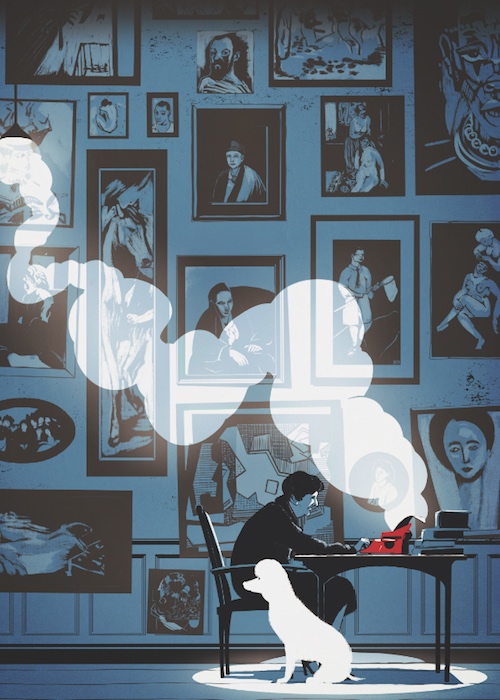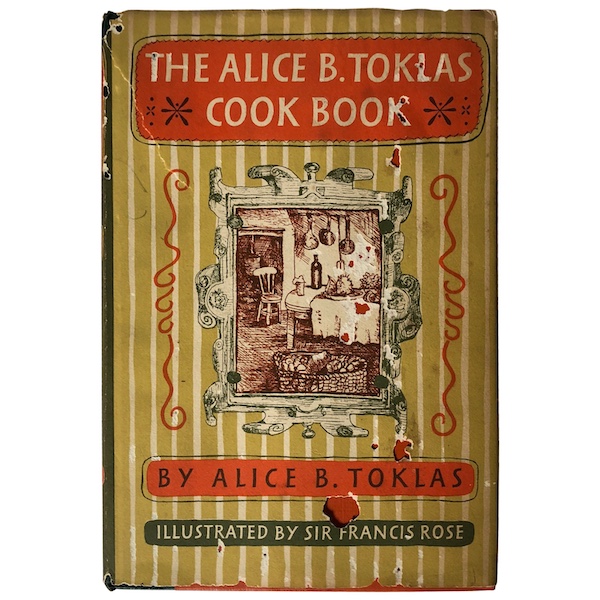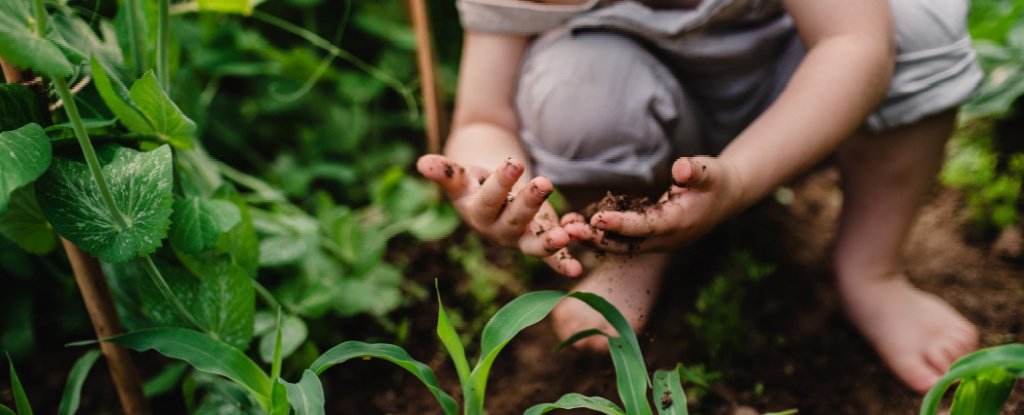EDIBLES
Bohemian Rhapsody
Illustrations by Ryan Garcia
How Alice B. Toklas became the accidental godmother of edibles.
By
John Birdsall
Published on December 9, 2019
“From the little old lady who gave you hashish fudge” read the headline in the February 1974 issue of Vogue. The profile of the late Alice B. Toklas turned out to be more tease than delivery, since none of the recipes attached to the article actually contained weed. Still, Toklas — who’d passed away seven years earlier, at age 89 — was, as the writer described her, “a counter-culture byword.”
Miss Toklas, in her prim clothing and stern expression in black-and-white photographs, seems an unlikely advocate for getting high. But, thanks to a recipe for
hashish fudge, published in 1954 in the British version of “The Alice B. Toklas Cook Book,” Toklas’s intelligent, brittle-looking and mustached face became an icon of the pot brownie, America’s first-gen edibles.
Perhaps the pinnacle of her cannabis notoriety came with the 1968 Hollywood rom-com “I Love You, Alice B. Toklas!” in which Peter Sellers plays an uptight attorney who unwittingly gorges on brownies laced with weed (shaken like dried oregano into a bowl of batter whipped up from a Pillsbury boxed mix), thereby precipitating a rethink of his life’s priorities.
Toklas’s journey to cannabis fame started in 1952, at a time when Toklas was desperate. Gertrude Stein, her de facto wife (the women had declared themselves married in 1910, though France, where they lived, did not legalize same-sex marriage until 2013), was dead. Although Stein was arguably the most famous American writer of her generation, and stacks of paintings by the likes of Picasso and Matisse filled their Paris apartment, Toklas needed money. Now, as a 73-year-old widow surrounded by a great art collection she refused to dismantle out of love for Stein’s memory, her situation had become dire. But Toklas had another collection she hoped would prove almost as valuable as the Picassos: her recipes.
(Photo courtesy of Bettman/Getty)
Food was one of Stein’s great passions, and Toklas took delight in cooking for her. Duck in Port wine, braised chicken stuffed with noodles, nougat ice cream, raspberry flummery: she would collect the recipes for these dishes all into a book. Through letters, a friend in New York introduced her to an agent. The publishing house Harper and Brothers agreed to buy her proposal for “The Alice B. Toklas Cook Book,” and promised to send her a contract and an advance in return for a partial manuscript. The money, Toklas realized with a sense of relief, would keep the wolves from circling.
But by March of 1953, she was straining to make her deadline. A 30,000-word chunk of the manuscript was due in April, with another 40,000 to be delivered in May. Toklas had never written a book before. She was finding it to be a slog. “You… see the grind this is,” Toklas wrote to a friend.
Toklas feared she might not have enough recipes to make her word count. For help, she wrote to the large and diverse circle of friends and acquaintances she and Stein had made in the expat bohemian underground: actors, composers, painters and models. She asked everyone — Picasso’s former mistress Dora Maar, the Turkish painter Nejad Devrim, the actress Fania Marinoff — to contribute a recipe or two.
“One chapter (how pretentious for me to write that)” she told a correspondent, with Toklas’s typical self-effacement, “will be devoted to recipes of friends — undoubtedly the only thing of merit in the deadly dull offering.”
One such friend was the 37-year-old English painter and writer
Brion Gysin. He’d met Stein and Toklas in the 1930s, but hadn’t kept in touch. In 1950, stalled in his art, unable to find a publisher and depressed with café life in Paris, Gysin had reached out to the widowed Toklas, who gave him grandmotherly encouragement to persevere. And when the expat American composer and author Paul Bowles met Gysin in Paris, and invited him to come stay at his home in the northern Moroccan port city of Tangier, Toklas urged Gysin to go. He intended to visit
Morocco for a summer; he stayed for 23 years.
Tangier had all the vestiges of a colonial city (Morocco was still a French protectorate), seething with American and European artists, ex-pats and rich tourists. Gysin, who was gay, took up with an aspiring young painter, Mohamed Hamri. The match proved fateful, as it was Hamri who showed Gysin local customs and culture, including how to pack a pipe with the cannabis-tobacco mix known as kif. Gysin wrote a long, ecstatic manuscript on the subject. It was the same enthusiastic tone that Gysin used to describe the recipe for hashish fudge (spelled “haschich”) that he sent Toklas for her book.
The Recipe for Hashish Fudge
“This is the food of Paradise — of Baudelaire’s Artificial Paradises,” Gysin wrote. “It might provide an entertaining refreshment for a Ladies’ Bridge Club or chapter meeting of the DAR. In Morocco it is thought to be good for warding off the common cold in damp weather and is, indeed, more effective if taken with large quantities of hot mint tea. Euphoria and brilliant storms of laughter; ecstatic reveries and extensions of one’s personality on several simultaneous planes are to be completely expected. Almost anything Saint Theresa did, you can do better if you can bear to be ravished by ‘
un évanouissement reveillé [a state of fainting while fully awake].’”
“Artificial Paradises” is a reference to French poet Charles Baudelaire’s 1860 book of essays about being high on opium and hashish: “Les Paradis Artificiels.” Gysin notes that, for anyone outside of Morocco, obtaining hash might be slightly tricky, although “the variety known as canibus [sic] sativa grows as a common weed, often unrecognized.” In America, he states, its cousin “canibus [sic] indica, has been observed even in city window boxes.” Gysin, obviously, was having a lark.
Of course, his confection isn’t really fudge (which, typically, contains milk or cream and implies a smooth texture) and it doesn’t even call for hashish. In fact, it’s a variation on the traditional Moroccan aromatic kif candy known as
majoun: smen (a kind of salty ghee) simmered with cannabis, strained, cooled and cooked again with spices, dates, honey, nuts and orange flower water.
Toklas was unaware that Gysin’s recipe yielded psychoactive results — and even forgot the recipe was in her book. In October 1954, weeks before “The Alice B. Toklas Cook Book” was to be released, Time Magazine caught a whiff, in galley form, of scandal.
“The late poetess Gertrude Stein… and her constant companion… Alice B. Toklas used to have gay old times together in the kitchen,” Time’s gossipy item read. “Perhaps Alice’s most gone concoction (and also a possible clue to some of Gertrude’s less earthy lines) was her hashish fudge.”
Toklas did not take Time’s drug-shaming well. “I was… furious,” she wrote a friend, “until I discovered it was really in the cook book!” She went on to write, “It is my ignorance not to have suspected what the few leaves were — of course I didn’t know their Latin name.” The laugh, she said, was on her.
Prohibition Begets Publicity
Her publisher wasn’t nearly so amused. In 1951, the U.S. Congress passed the
Boggs Act. It set mandatory sentences for drug convictions — a first offender convicted of cannabis possession faced a minimum sentence of two to ten years and a ruinous fine as high as $20,000. Harper and Brothers sent a telegram to the U.S. Attorney General, asking: Would it be a crime to publish a recipe that praised cannabis and sent the curious out to score some? In fact, it wasn’t illegal to merely publish such a recipe. Still, Harper was skittish, and deleted Gysin’s recipe from the American edition (though it appeared in the U.K. version).
Even suppressed, “Haschich Fudge” sealed Toklas’s reputation. The haze of notoriety around “The Alice B. Toklas Cook Book” made Americans curious. “It sold seven thousand copies in its first month in the United States,” Justin Spring writes in “The Gourmands’ Way,” “and within three weeks of its publication, it had gone into its fourth printing.”
Toklas got her royalties, and the impish-looking, 77-year-old bohemian widow of the famous Gertrude Stein took on the status of an underground hero. Toklas didn’t mind. The writer Thornton Wilder thought the whole business made his old friend look like a sly genius.
“Thornton said that no one would believe in my innocence,” she wrote to a friend after “The Alice B. Toklas Cook Book” had become an instant classic, “as I had pulled the best publicity stunt of the year.”










